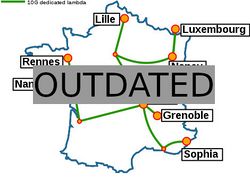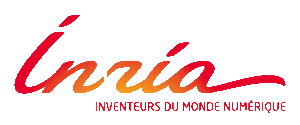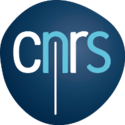Grid5000:Home: Difference between revisions
No edit summary |
No edit summary |
||
| Line 7: | Line 7: | ||
Key features: | Key features: | ||
* provides '''access to a large amount of resources''': | * provides '''access to a large amount of resources''': 15000 cores, 800 compute-nodes grouped in homogeneous clusters, and featuring various technologies: GPU, SSD, NVMe, 10G and 25G Ethernet, Infiniband, Omni-Path | ||
* '''highly reconfigurable and controllable''': researchers can experiment with a fully customized software stack thanks to bare-metal deployment features, and can isolate their experiment at the networking layer | * '''highly reconfigurable and controllable''': researchers can experiment with a fully customized software stack thanks to bare-metal deployment features, and can isolate their experiment at the networking layer | ||
* '''advanced monitoring and measurement features for traces collection of networking and power consumption''', providing a deep understanding of experiments | * '''advanced monitoring and measurement features for traces collection of networking and power consumption''', providing a deep understanding of experiments | ||
Revision as of 21:53, 19 January 2020
|
Grid'5000 is a large-scale and flexible testbed for experiment-driven research in all areas of computer science, with a focus on parallel and distributed computing including Cloud, HPC and Big Data and AI. Key features:
Grid'5000 is merging with FIT to build the SILECS Infrastructure for Large-scale Experimental Computer Science. Read an Introduction to SILECS (April 2018)
Older documents:
|
Random pick of publications
Five random publications that benefited from Grid'5000 (at least 2517 overall):
- Wedan Emmanuel Gnibga, Anne Blavette, Anne-Cécile Orgerie. Renewable Energy in Data Centers: the Dilemma of Electrical Grid Dependency and Autonomy Costs. IEEE Transactions on Sustainable Computing, 2023, pp.1-13. 10.1109/TSUSC.2023.3307790. hal-04189173 view on HAL pdf
- Quentin Guilloteau, Jonathan Bleuzen, Millian Poquet, Olivier Richard. Transposition d'environnements distribués reproductibles avec NixOS Compose. COMPAS 2022 - Conférence francophone d'informatique en Parallélisme, Architecture et Système, Jul 2022, Amiens, France. pp.1-9. hal-03696485v2 view on HAL pdf
- John Baena, Pierre Briaud, Daniel Cabarcas, Ray Perlner, Daniel Smith-Tone, et al.. Improving Support-Minors rank attacks: applications to GeMSS and Rainbow. CRYPTO 2022 - 42nd Annual International Cryptology Conference, Aug 2022, Santa Barbara (CA), United States. pp.376--405, 10.1007/978-3-031-15982-4_13. hal-03533455v2 view on HAL pdf
- Clément Courageux-Sudan, Anne-Cécile Orgerie, Martin Quinson. A Wi-Fi Energy Model for Scalable Simulation. WoWMoM 2023 - 24th IEEE International Symposium on a World of Wireless, Mobile and Multimedia Networks, Jun 2023, Boston (MA), United States. pp.1-10. hal-04055720 view on HAL pdf
- Daniel Rosendo. Methodologies for Reproducible Analysis of Workflows on the Edge-to-Cloud Continuum. Distributed, Parallel, and Cluster Computing cs.DC. INSA RENNES, 2023. English. NNT : . tel-04167278 view on HAL pdf
Latest news
Failed to load RSS feed from https://www.grid5000.fr/mediawiki/index.php?title=News&action=feed&feed=atom: Error parsing XML for RSS
Grid'5000 sites
Current funding
As from June 2008, Inria is the main contributor to Grid'5000 funding.
INRIA |
CNRS |
UniversitiesUniversité Grenoble Alpes, Grenoble INP |
Regional councilsAquitaine |


